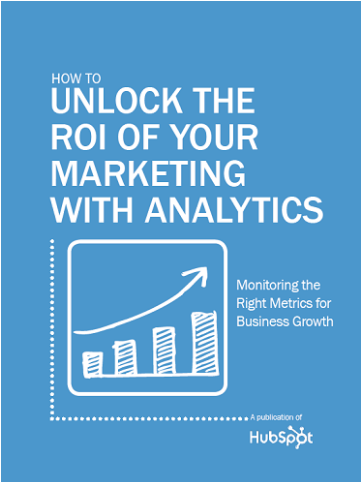In this article, I’ll share lead scoring models for you to consider, which data to look at, how to calculate a lead score, and what to do with a lead score once you have one.
Table of Contents
- What is lead scoring?
- Lead Scoring Models
- How to Determine What Data to Look At
- Is one lead score enough?
- How to Calculate a Basic Lead Score
- Lead Scoring Best Practices
What is lead scoring?
Lead scoring is the process of assigning a score or value to each lead which reflects how likely they are to become a customer. This process allows companies to prioritize and focus their energy on leads who are most likely to convert.
You can score your leads based on multiple attributes, including the professional information they‘ve submitted to you and how they’ve engaged with your website and brand across the internet.
Learn more about the concept of lead scoring in the video below:
Lead scoring sounds easy, right? Depending on your business model and the leads in your database, it can quickly become complicated.
To make this process a little easier, I will walk you through the basics of creating a lead score, including what data you should look at, how to find the most important attributes, and the process for calculating a basic score.
Do you need a lead scoring model?
If you’re a small business or startup, you may not be sure if you really need a lead scoring system. While sales reps at smaller companies can sometimes “feel out” their leads based on intuition, that system will pretty quickly hit limits as you scale. Here are some signs that you have tipped the scales and need a lead scoring model:
- Your sales team has more leads than they can respond to in a timely fashion.
- Your sales team wastes its time on low-quality leads that don’t convert.
- Your sales reps don’t have a strategy for who to prioritize to in their pipeline.
- Your team’s closing rate is lower than you would like.
Why is lead scoring important?
You may be wondering if lead scoring is outdated or if it’s still a relevant sales method. The short answer is lead scoring is as important today as it has been for years.
I’ve seen firsthand that lead scoring leads to better ROI for your sales efforts and helps to close more sales through a personalized, targeted approach.
We’ve seen in our data that 53% of salespeople say selling got harder in the past year. Mark Osborne, B2B sales expert and founder of Modern Revenue Strategies, says that for many businesses, markets are tightening due to uncertainty and higher interest rates, which has resulted in less capital. These tighter markets and longer sales cycles make every lead more precious.
Without a lead scoring model in place, says Osborne, you could be losing business to the competition.
“Savvy competitors have learned to swarm on the best opportunities as soon as they identify them,” he says, “giving those prospects the highest level of personalized attention and service to win those crucial deals.”
Lead Scoring Models
There are multiple lead scoring models that use different attributes and metrics to score leads. Many lead scores are based on a point range of 0 to 100, but every model you create will support a particular attribute of your core customer.
Here are seven different lead scoring models based on the type of data you can collect from the people who engage with your business. Choose the one that best matches your marketing strategy and the data you have available.
1. Firmographic or Demographic Information
Are you only selling to people of a certain demographic, like parents of young children? Or a certain ideal customer profile (ICP), like CIOs? Asking demographic (B2C) or firmographic (B2B) questions in your lead acquisition forms can help you see how well they fit in with your target audience.
For instance, you can assign point values for people who fit in your target geography, job title, or industry. You can also ask intent questions, like “Why are you interested in getting in touch with us?” with a few multiple-choice options. This model is also called explicit lead scoring because it uses the information that a lead gives you explicitly.
On the firmographic side, try tracking external company data on company information such as new leadership, M&A activity, or new investments as this knowledge can be valuable in understanding the company's current context and fit with your value proposition.
While you don’t want to waste your lead’s time making them answer a long form, you can use a data enrichment tool to automatically supplement the information a lead submits.
2. Behavioral/Engagement Data
If someone opts in to receive emails from your company by filling out an email popup, you still don’t know much about how interested that person is in buying from you.
Open and click-through rates, on the other hand, will give you a much better idea of their interest level. Examining behavioral data — like how many emails a lead opens and which ones — can indicate whether a prospect is engaged.
Similarly, a lead’s engagement with your brand on social networks can also give you an idea of how interested they are. In my experience, social media is tied to referrals for generating the highest-quality leads, so it’s not a channel to overlook. How many times did they click through on your company's tweets and LinkedIn posts? How many times did they comment or share those posts?
These types of inferences are called implicit lead scoring. By identifying interactions and behaviors that signify interest, you can gauge levels of interest.
3. Lead Sources
Though it may seem simple, quantifying a lead according to its source is another way to score leads. Most sales teams already know which sources provide the best leads, or can run a simple historical analysis to find out.
Since referrals are one of the best lead sources for most brands, you could assign more points to leads from referrals so your sales reps can prioritize reaching out to them.
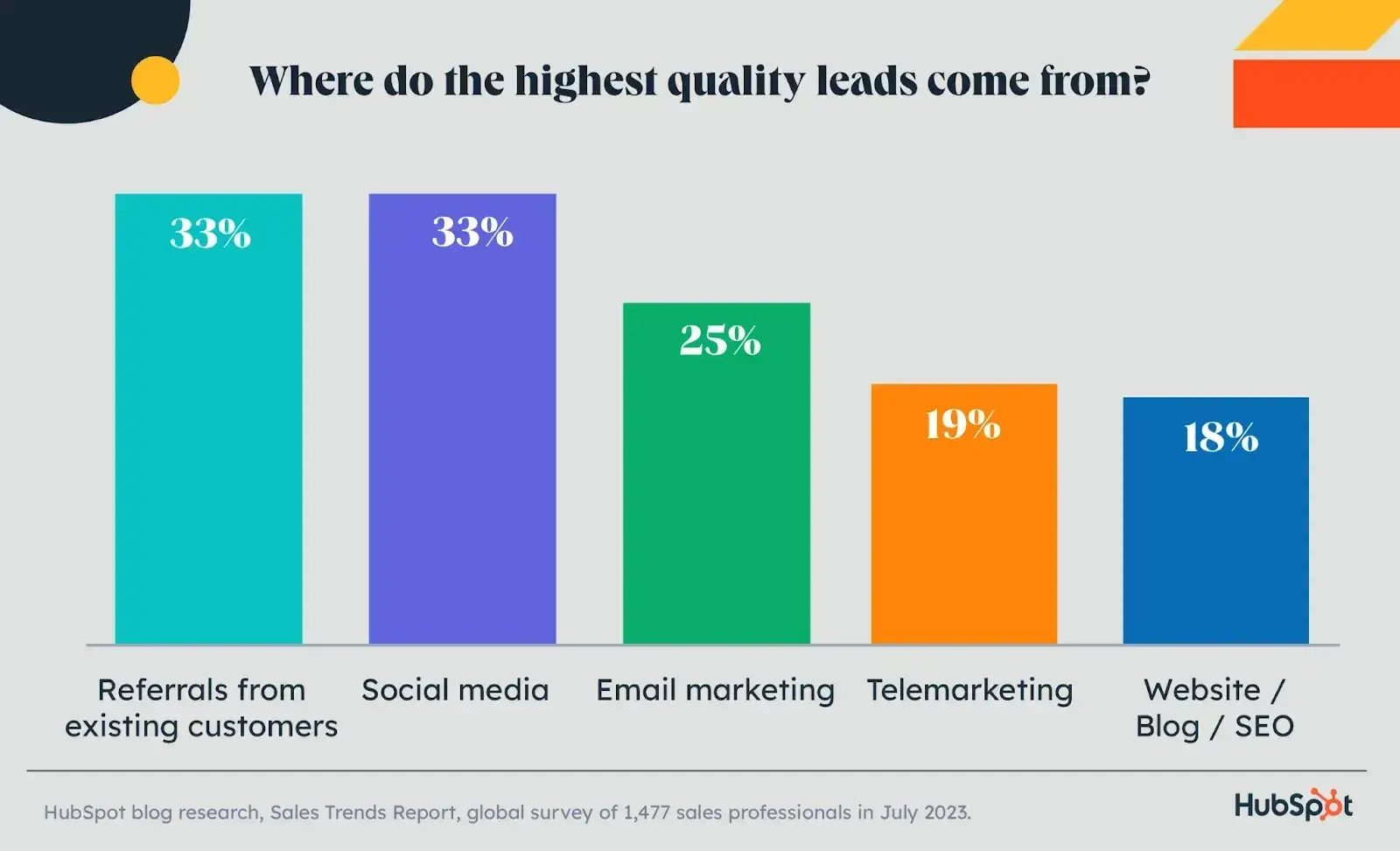
If you’re not already collaborating with your marketing team to get this data, start now, recommends Grant.
“Our sales and marketing team are in constant communication, ensuring that the criteria we use for scoring are aligned with real-world results,” he says. “This synergy helps refine our lead scoring models and improve accuracy.”
4. Purchase Intent Model
In my experience, how a lead interacts with your website tells you a lot about their interest and intentions. The purchase intent model uses intent data to gauge a lead's likelihood of conversion by analyzing their web activity, behavior, and in some cases fit and demographics.
Take a look at your leads who eventually become customers: Which offers did they download? How many offers did they download? Which pages — and how many pages — did they visit on your site before becoming a customer? With a little bit of historical data, you can identify common behaviors to look for, like visiting the pricing page.
Both the number and types of type and pages are important. You might give higher lead scores to leads who visited certain pages (like pricing pages) or filled out high-value forms (like a demo request). Similarly, you might give higher scores to leads who had 30 page views on your site, as opposed to three.
Similarly, you can give negative points to someone who stopped visiting your website or opening your emails.
With HubSpot, for instance, you can build a custom lead-scoring model based on fit, engagement metrics, or a combination of both. You can also identify purchase signals with the analytics in the platform.
5. Predictive Intelligence
Predictive lead scoring takes the purchase intent model a step further by providing predictive intelligence. Instead of manually assigning scores by behavior or demographic, predictive lead scoring models use AI and machine learning to identify patterns and predict conversion likelihood. The scoring for predictive intelligence is dynamic and adjusts over time as new data becomes available.
While a purchase intent model shows you who’s ready to buy right now, predictive intelligence analyzes patterns to show who may be ready to buy in one, three, or six months.
6. Negative Scoring and Spam Detection
Last but not least, you should give negative scores to leads who filled out landing page forms in ways that could indicate they're spam or not interested in buying.
For example, were first name, last name, and/or company name not capitalized? Did the lead complete any form fields by typing four or more letters in the traditional “QWERTY” keyboard, or a phone number like 999-999-9999?
You might also want to think about which types of email addresses leads are using compared with the email addresses of your customer base. If you're selling to businesses, for example, you might take points away from leads who use a Gmail or Yahoo! email address.
How to Determine What Data to Look At
There's a lot of data to weed through — how do you know which data matters most? Should you find out from your sales team? Should you interview your customers? Should you dive into your analytics and run a few reports?
I recommend a combination of all three. Your sales team, your customers, and your analytics reports will all help you piece together what content is most valuable for converting leads into customers, which will help you attach a number of points to certain offers, emails, and so on.
Coordinate across teams.
“The biggest lift in lead scoring is not defining how many points something is worth, it's making sure everyone internally is aligned,” advises Ryan Durling, Inbound Consultant for HubSpot, in a webinar with HubSpot Admin HUG.
“It’s very important that before you embark on any sort of lead scoring approach that you have buy-in from everyone who‘s a stakeholder, who’s going to be involved. That’s not just the salespeople, it‘s not just the content team it’s not just the folks who are responsible for reporting or operations — it's everyone.”
Sales reps are the ones on the ground, communicating directly with both leads who turned into customers and those who didn't. They tend to have a good idea of which pieces of marketing material help encourage conversion.
Talk to your customers.
While your sales team might claim certain content converts customers, you might find that the people who actually went through the sales process have different opinions. That's okay: You want to hear it from both sides.
In fact, according to our 2024 State of Sales Report, building and maintaining a strong rapport with customers is a key focus area for sales professionals.
Conduct a few customer interviews to learn what they think was responsible for their decision to buy from you. I suggest you interview customers who have had both short and long sales cycles so you get diverse perspectives.
Turn to the analytics.
I recommend that you also complement all this in-person research with hard data from your marketing analytics.
Run an attribution report to figure out which marketing efforts lead to conversions throughout the funnel. Don‘t only look at the content that converts leads to customers — what about the content people view before they become a lead?
You might award a certain number of points to people who download content that’s historically converted people into leads and a higher number of points to people who download content that's historically converted leads into customers.
Another way to help you piece together valuable pieces of content on your site is to run a contacts report. A contacts report will show you how many contacts — and how much revenue — have been generated as a result of certain, specific marketing activities.
Marketing activities might include certain offer downloads, email campaign click-throughs, and so on. Take note of which activities tend to be first-touch conversions, last-touch conversions, and so on, and assign points accordingly.
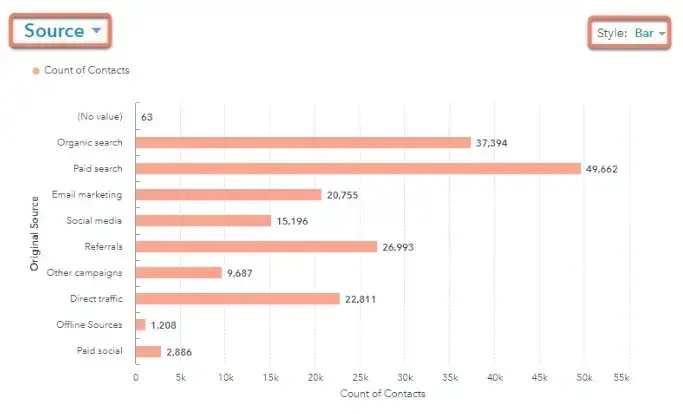
Is one lead score enough?
If you have one core customer right now, a single score suffices. But as your company scales, you'll sell to new audiences. You might expand into new product lines, new regions, or new personas.
You might even focus more on up-selling and cross-selling to existing customers rather than pursuing new ones. In my experience, if your contacts aren‘t “one size fits all,” your scoring system shouldn’t be either.
With some marketing platforms, you can create multiple lead-scoring systems, giving you the flexibility to qualify different sets of contacts in different ways. Not sure how to set up more than one score? I’ve gathered a few examples to inspire you:
Fit vs. Interest
Let’s say, for instance, your sales team wants to evaluate customers on both fit (e.g., is a contact in the right region? The right industry? The right role?) and interest level (e.g., how engaged have they been with your online content?).
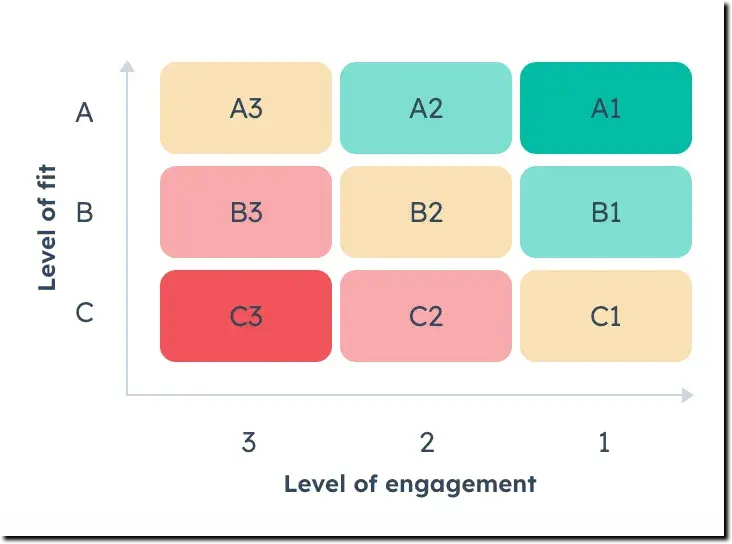
If both of these attributes are a priority, you can create both an engagement score and a fit score (as seen in the graphic above) so that you can prioritize outreach to contacts whose values are high in both categories.
Multiple Personas
Say you’re a software company that sells two different types of software via different sales teams to different types of buyers.
You could create two different lead scores — one for a buyer’s fit and the other for their interest in each tool. Then, you’d use these respective scores to route leads to the right sales teams.
New Business vs. Up-sell
As you grow, you might start to focus on upselling or cross-selling as much as new business. However, keep in mind that the signals that indicate the quality of new prospects and existing customers often look completely different.
For prospects, you might look at demographics and website engagement, whereas for existing customers, you might look at how many customer support tickets they've submitted, their engagement with an onboarding consultant, and how active they currently are with your products.
If these buying signals look different for different types of sales, consider creating multiple lead scores.
How to Calculate a Basic Lead Score
There are many different ways to calculate a lead score, but I think the simplest way to do it is this:
Featured Resource: Free Lead Scoring Template
Manual Lead Scoring
1. Calculate the lead-to-customer conversion rate of all of your leads.
Your lead-to-customer conversion rate is equal to the number of new customers you acquire, divided by the number of leads you generate. Use this conversion rate as your benchmark.
2. Pick and choose different attributes of customers who you believe were higher quality leads.
Customers who requested a free trial at some point, customers in the finance industry, or customers with 10-20 employees could be attributes.
There‘s a certain kind of art to choosing which attributes to include in your model. You’ll choose attributes based on those conversations you had with your sales team, your analytics, and so on — but overall, it's a judgment call.
You could have five different people do the same exercise, and they could come up with five different models. But that's okay as long as your scoring is based on the data we mentioned previously.
3. Calculate the individual close rates of each of those attributes.
Calculating the close rates of each type of action a person takes on your website — or the type of person taking that action — is important because it dictates the actions you'll take in response.
So, figure out how many people become qualified leads (and ultimately customers) based on their actions or who they are in relation to your core customer. You'll use these close rates to actually “score” them in the step below.
4. Compare the close rates of each attribute with your overall close rate and assign point values accordingly.
Look for the attributes with close rates that are significantly higher than your overall close rate. Then, choose which attributes you’ll assign points to, and if so, how many points.
Base the point values of each attribute on the magnitude of their individual close rates.
The actual point values will be a little arbitrary but try to be as consistent as possible.
For example, if your overall close rate is 1% and your “requested demo” close rate is 20%, then the close rate of the “requested demo” attribute is 20X your overall close rate — so you could, for example, award 20 points to leads with those attributes.
Logistic Regression Lead Scoring
The simple method above for calculating a lead score is a great start. However, the most mathematically sound methods employ a data mining technique, such as logistic regression.
Data mining techniques are more complex and often more intuitive than your actual close rates. Logistic regression involves building a formula in Excel that’ll spit out the probability that a lead will close into a customer.
This is more accurate than the technique I outlined above since it’s a holistic approach that takes into account how all of the customer attributes — like industry, company size, and whether or not someone requested a trial — interact with one another.
If you prefer a less complex lead-scoring method, I think the manual approach above is a great place to start.
Predictive Lead Scoring
Creating a lead score can do great things for your business: improve the lead-handoff process, increase lead conversion rate, improve rep productivity, and more.
But, as you can see from the two methods above, coming up with a scoring system can be a time-consuming task when done manually.
Plus, coming up with scoring criteria isn‘t “set it and forget it.” As you get feedback from your team and stress-test your scores, I’ve found you’ll need to tweak your lead-scoring system regularly to ensure it remains accurate.
Wouldn't it be easier if technology could eliminate the manual setup and continuous tweaking, leaving your team more time to build relationships with your customers?
That's where predictive scoring comes in. Predictive lead scoring uses machine learning to parse through thousands of data points in order to identify your best leads, so you don't have to.
Predictive scoring looks at what information your customers have in common, as well as what information the leads that didn't close have in common, and comes up with a formula that sorts your contacts by importance based on their potential to become customers.
This allows you and your sales team to prioritize leads so you're not harassing those who aren't (yet) interested and engaging those who are.
The best part about predictive scoring? As with any application of machine learning, your predictive score gets smarter over time, so your lead follow-up strategy will optimize itself.
Featured Resource: Predictive Lead Scoring Software
Lead Scoring Best Practices
We’ve covered a lot so far, so I want to wrap it up with a few best practices I learned from the sales leaders I spoke to.
Here are some lead scoring best practices to follow if you want to improve your sales in 2024.
Leverage AI and machine learning.
In the age of AI, sales professionals would be wise to use one of the numerous AI tools to their selling advantage, especially during the lead scoring process.
Not only can AI tools improve efficiency, but 66% of sales pros say that AI helps them provide a personalized experience and better understand their customers.
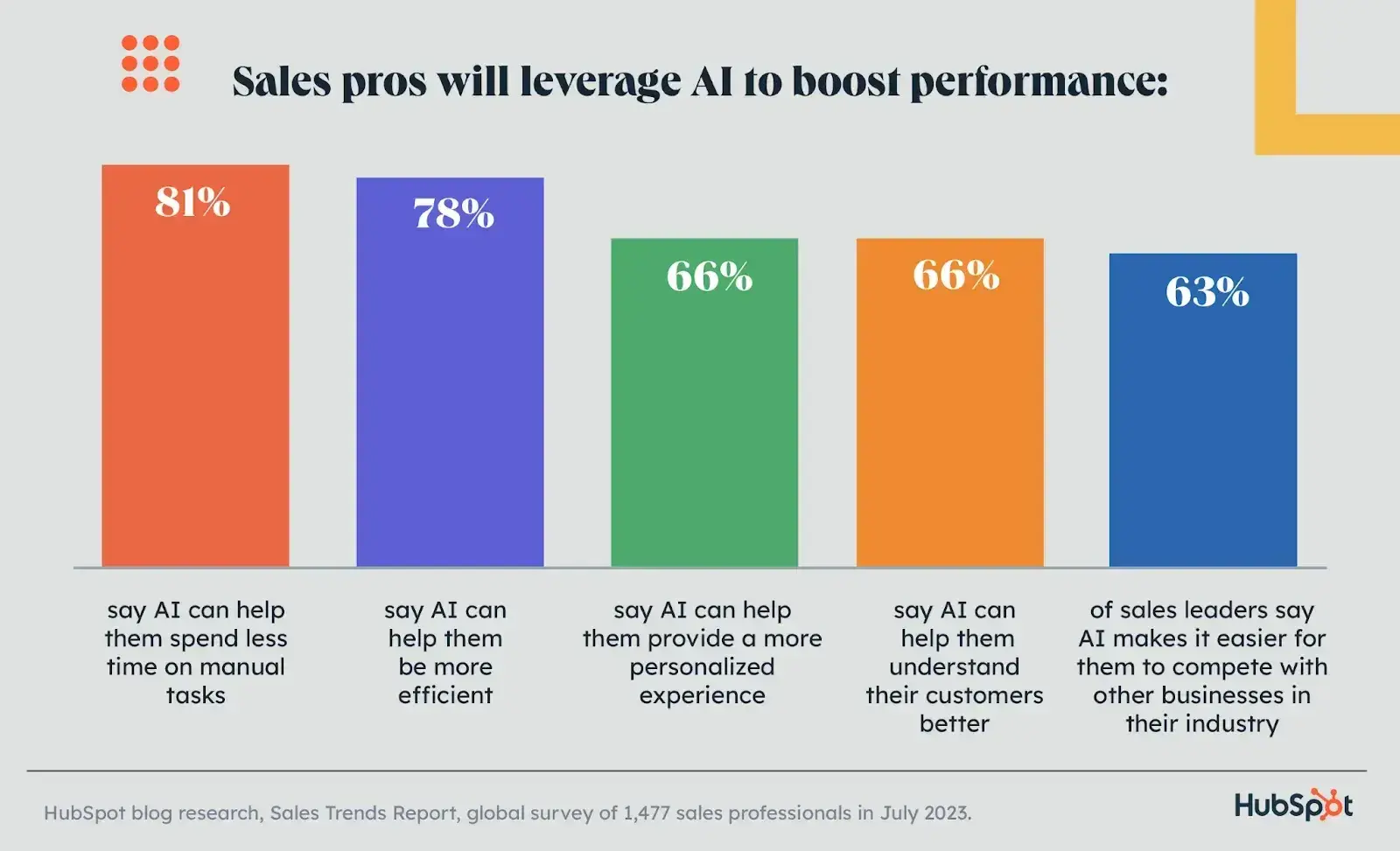
Grant is also taking advantage of AI’s power to personalize data.
“We’re leveraging AI to analyze patterns and predict which leads are most likely to convert,” he says. “Machine learning models can adapt and get more accurate over time, which is a huge step up from traditional lead scoring methods.”
Lead with data.
I think one of the best parts about lead scoring is that it’s an objective method. When the data indicates how interested a prospect is, that’s something you’ll want to lean into.
Data is one of the most important resources sales teams and marketers have at their disposal, and lead scoring has become even more data-driven with the tools available today.
If you want to save time spent on unqualified leads and prioritize sales-ready ones with data-driven decisions, then your sales team should use a lead scoring model that makes it easy to organize and understand your data.
Make real-time adjustments.
If you think lead scoring models are outdated, it could be because the traditional methods didn’t take into account real-time industry or business changes.
“Lead scoring is no longer a set-it-and-forget-it deal,” says Grant. “We’re making real-time adjustments based on the latest data. This agility helps us stay ahead of the curve and respond to changing market conditions.”
There are so many lead generation tools available to help your sales team make real-time decisions and properly qualify inbound leads.
Create workflows and automations based on scores.
A lead score is just a number— it’s what you do with that number next that counts.
“Lead scores on their own are not actionable. A successful approach to lead scoring will involve automation to make sure that contacts are getting routed to the right people, that they’re getting nurtured with the right content, and they're getting served the most custom experience that you can possibly serve them,” says Durling.
“If you don‘t have a strong assignment rule or a strong series of assignment rules for contacts coming into your database, lead scoring isn’t likely going to be very valuable for you because you're just going to put contact every contact into the same funnel and nurture flow,” he warns.
The next step for a lead who’s high engagement/low fit may be different than for a lead that’s low engagement/high fit. In addition, a vast majority of leads will need to be nurtured before they're ready to be handed off to sales.
Here are different actions you can automate in your score based on a lead score:
- Start a nurture campaign appropriate to the demographics and behavior.
- Route leads to different reps when the lead score surpasses your MQL (Marketing Qualified Lead) criteria.
- Recommend personalized content based on industry or behavior (eg. a case study from their industry or related content from a previous download).
Above all, I believe that lead scoring allows you to create a more personalized, timely, and relevant experience that makes it more likely for them to buy.
“The scoring model and the buyer personas work together to create the most personalized experience for your prospects. When you create a more personalized experience, you create trust a lot more quickly,” says Durling.
Improve Your Sales With Lead Scoring
Scoring your leads can go a long way in determining which leads are good fits and interested in your offering and which might need more nurturing before being sales-ready. Whether you use a manual calculation method
Check out our lead scoring templates to get started defining your criteria and assigning points!
Editor's note: This post was originally published in August 2015 and has been updated for comprehensiveness.
Lead Nurturing


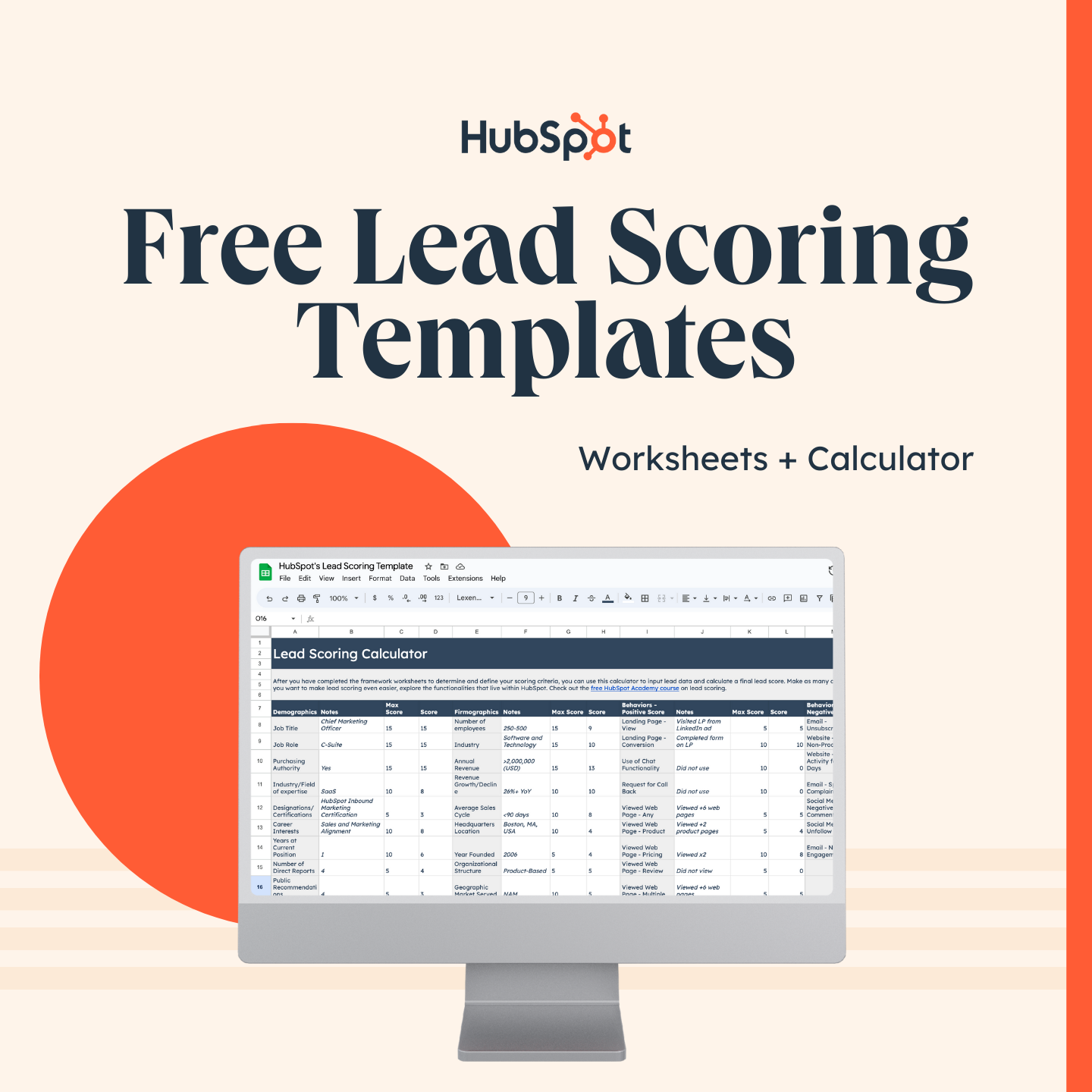


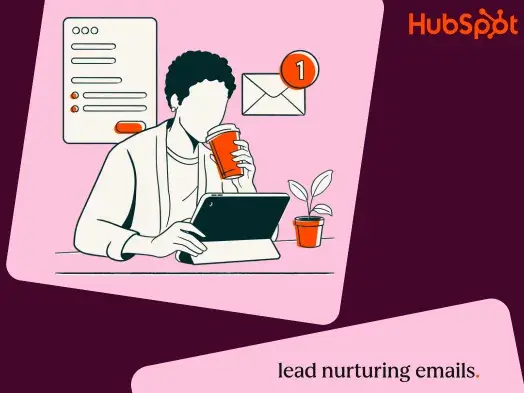

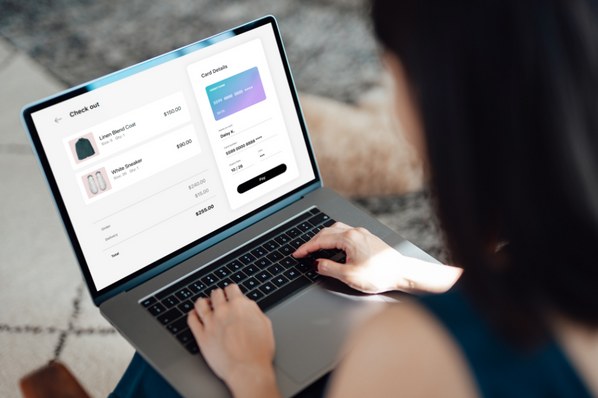




![How to Expand Your Lead Nurturing Strategy Beyond Just Email [SlideShare]](https://53.fs1.hubspotusercontent-na1.net/hub/53/file-1390659247-jpg/Blog_Thinkstock_Images/lead_nurturing.jpg)

